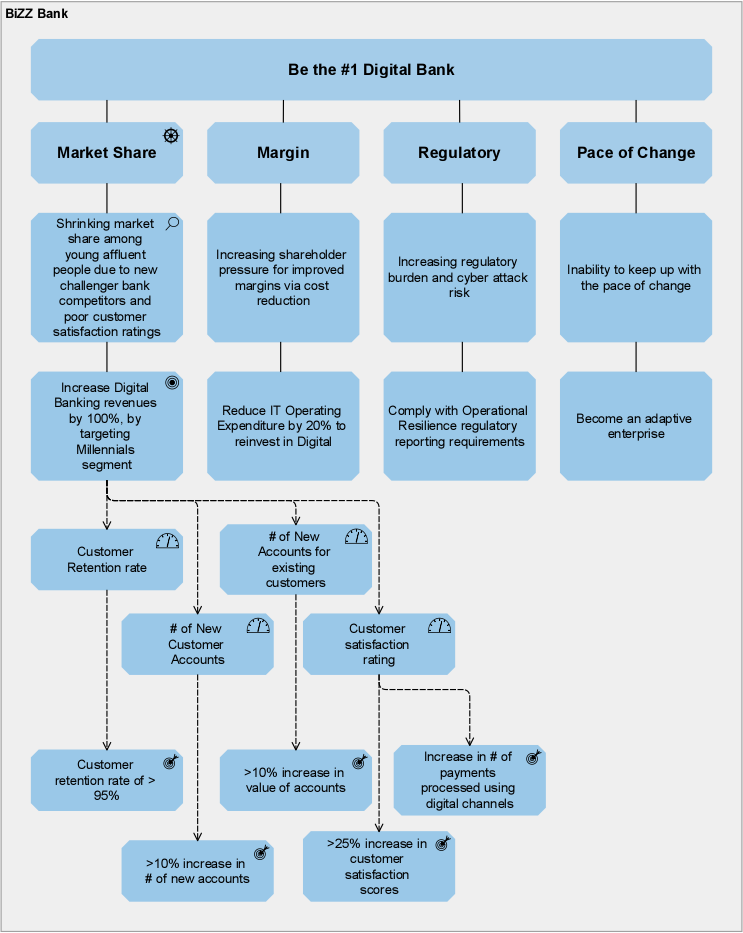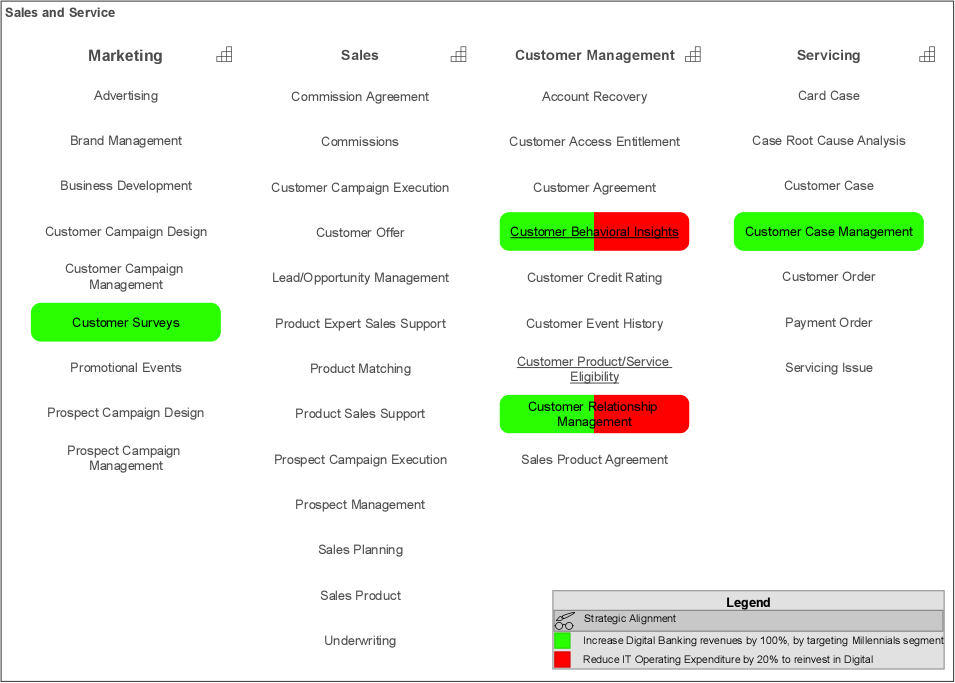Digital transformation has become a standard practice for organizations aiming to stay competitive in a rapidly evolving landscape. With advancing technology, demanding consumers, and low barriers to entry, businesses understand that the status quo is no longer sustainable. However, the importance of defining clear digital KPIs is often overlooked. This oversight results in initiatives that lack direction and resemble knee-jerk reactions rather than well-thought-out strategies.
Digital KPIs act as a guiding framework, aligning all efforts toward a common goal. They provide a structured “game plan” that ensures projects, investments, and strategic decisions are focused on achieving the desired outcomes. While balancing conflicting KPIs can be challenging, the clarity they bring significantly enhances progress. In practice, this alignment means every decision—whether related to technology, people, or strategy—directly contributes to the success of the transformation effort.
Imagine an organization that approaches its transformation journey with deliberate intent, prioritizing meaningful outcomes over quick fixes. Such an organization understands the importance of establishing digital KPIs but recognizes the complexity of doing so, particularly for traditional enterprises embarking on their first large-scale digital transformation. So, how should they proceed?
One common approach is to emulate what other organizations have done. While this can offer a starting point, its success hinges on how similar the “model company” is to the “apprentice company.” If their organizational variables align closely, a lift-and-shift strategy might work. However, if the two organizations differ significantly, this approach often falls short. Simply copying a competitor’s playbook without tailoring it to your unique context can lead to wasted efforts. Competitors’ successes are often the result of careful planning and customization, not just replicable steps. Relying on a fear-of-missing-out strategy rarely delivers transformational results.
This is where option two becomes critical: looking inward. Every organization is unique, shaped by its internal dynamics, external environment, and distinctive characteristics. Successful digital transformation requires identifying digital KPIs that align with the organization’s specific needs and goals. This involves deep introspection—examining the company’s structure, culture, and strategic objectives to create a bespoke transformation program. Unlike the one-size-fits-all approach, this method demands significant effort and perseverance but is far more likely to produce meaningful, sustainable change.
In essence, tailoring digital KPIs to reflect the organization’s DNA ensures that every action taken—whether strategic or tactical—is purpose-built to drive the desired outcomes. It’s not the easy route, but it’s the one that delivers long-term success.
This is where Enterprise Architecture comes in. Let’s have a look at how it supports organizations that want to leverage digital KPIs to increase their digital transformation’s probability of success.
1. Define a goal
The first step, if you’re taking the digital KPIs route, is to settle on a clear digital goal, e.g. fully digitizing the customer experience for transitioning from one financial product (an entry-level debit card) to another (a premium card that offers certain benefits). This ensures you won’t waste any time and resources chasing the wrong rabbit. EA plays a major role at this point because it provides a comprehensive view of the company’s business and IT landscapes. Therefore, the team spearheading the transformation efforts can access reliable information on how the business layer with its capabilities, processes etc. interacts with – and is indeed supported by – the application and technology layers. Here is another example in the visual below, this time illustrating an Increase Digital Banking revenues by 100% by targeting millennials goal, which is further decomposed into digital KPIs.

Also, here is another visual created in Bizzdesign Horizzon below that illustrates how this aligns with another goal to Reduce IT Operating Expenditure by 20% to Reinvest in Digital.

Taking a step further into this direction, it wouldn’t be a stretch to imagine this being connected at the top to the strategy and business model side of things. If the initiative is truly transformative, it must be strategic as well. On the more operational side, EA could shed some light into the processes that are currently in place, highlighting where the most acute problems are, or where most value-add lies – important things to know as you set out to ‘remodel’ the organization.
Of course, the more granular the preoccupation the less it would come into play at this stage, and the farther outside the scope of architecture it would straggle. But, depending on the specifics of the scenario, these may be relevant even at an early stage. In any case, it’s safe to say that at this point enterprise architecture will help you turn a somewhat poorly defined grievance into a clear objective.
2. Identify relevant metrics
Once you have settled on a digital goal, you suddenly have a better idea of what you should monitor – inadvertently, an initial metrics selection takes place. Now you can further refine this list and get it down to a more manageable size, with more relevant content. A good approach would be to try and include metrics that resonate with both internal stakeholders (from the business and IT side) and customers. So, for example, feature elements that would make the Chief Enterprise Architect (or Chief Operations Officer) happy – metrics around the rate of progress of digitization initiatives within different departments, the digitalization of the workplace, improved collaboration between employees, automating processes, etc. But be sure also to include ones that would please the CFO, such as metrics relating to an increase in the bottom line via digitalization – new revenue facilitated by new digital capabilities, a lower churn rate, a higher lifetime customer value etc. That accounts for people inside the company. Now think of your audience and how their interests might be represented here. You have a solid group of metrics to work with.
In this instance, too, enterprise architects prove valuable. As a liaison between management and operational roles, they can ensure the proposed metrics are connected to the business reality. Are executives providing business feedback incompatible with metrics used to measure IT infrastructure and applications? Maybe application owners are unresponsive to how application performance is impacting business performance. Whatever it may be, if there’s a group that can provide an integrated view on the inner workings of the enterprise and make opposing camps find common ground, that’s architects.
3. Select the Digital Transformation KPIs
Establishing a strong framework of relevant metrics positions you well to define your digital key performance indicators (KPIs). This stage is critical for collaboration with management. Enterprise Architecture plays a key role here by enabling the creation of clear and actionable business cases for digitalization targets, which, in turn, guide the selection of meaningful KPIs.
To enhance the utility of your KPIs, you could align them with traditional metrics, such as those used in a Balanced Scorecard, or develop a tailored “Digital Scorecard” to provide management with actionable insights. Having well-defined objectives—specific subsets of your overarching goals—leads to a clearer understanding of the anticipated benefits when discussing desired outcomes. However, these objectives cannot be based on assumptions alone. They must be grounded in the realities of the IT infrastructure and the availability and constraints of business services and interfaces. This is another area where the visibility provided by architectural insights proves invaluable.
Ultimately, while there is considerable flexibility in defining KPIs, the most effective ones remain focused on business impact, are clear in their purpose, and are measurable. Following these principles ensures you develop a relevant and actionable digital KPIs.
ALSO READ: Master Enterprise Architecture Management with our wiki
4. Monitor, reassess, improve
This fourth bullet point is dedicated to ‘continuous improvement’. That’s because irrespective of how well you plan and prepare, there are certain aspects of any project that only become apparent with time. In this case, EA keeps track of the direction and progress of change, offering a reliable record of the initiative at various stages in time. Checking that against the KPIs or other unforeseen developments provides a background for analysis, and possible opportunities to course correct. You can even imagine spotting trends and making forecasts based on these measurements. That will let you proactively carry out changes before the immediate need arises. Experience might point towards the fact that a certain KPI is not as valuable as you believed, or in fact, you might identify a new KPI that makes a lot of sense but wasn’t spotted initially. To track and keep tabs on the progress of a digital transformation program effectively, you need to be willing to change these – the things you measure need to evolve as well! Enterprise architecture makes knowing what you are trying to achieve and what to track more evident and quickly.
Conclusion
To conclude, digital transformation KPIs are not only complex affairs but also very particular. As such, their success depends closely on how accurately they reflect the unique reality of the enterprise, and therefore how relevant the performance indicators selected to drive and measure progress are. Since this boils down to deep organization knowledge, enterprise architecture stands out as the go-to solution for defining and assessing the best possible digital KPIs.
In fact, during such vital programs, architects have the opportunity and responsibility to act as a first-tier advisory function to management. With their background in technology and business and leveraging the key insights they produce, enterprise architects can ensure management gets all the support they need to formulate a fact-based strategy forward.